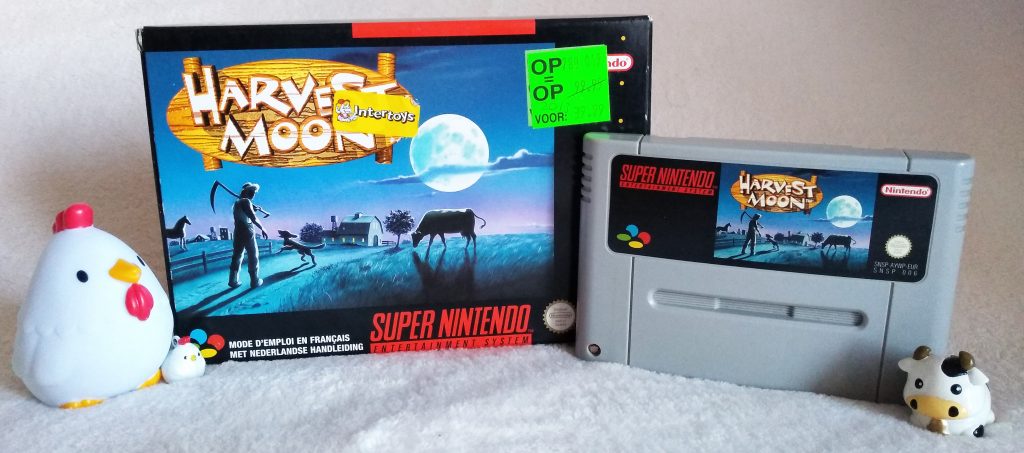
Platform: Super Nintendo Entertainment System
Release Date:
JPN: August 9, 1996
NA: June 1997
EU: January 29, 1998
Publisher: Natsume, Inc.
Developer: Amccus
Genre: Simulation
Saves: 2 separate save slots
Harvest Moon on the SNES is still one of my favourite video games of all time. It was one of the first video games I played on the SNES and got me hooked on the system.
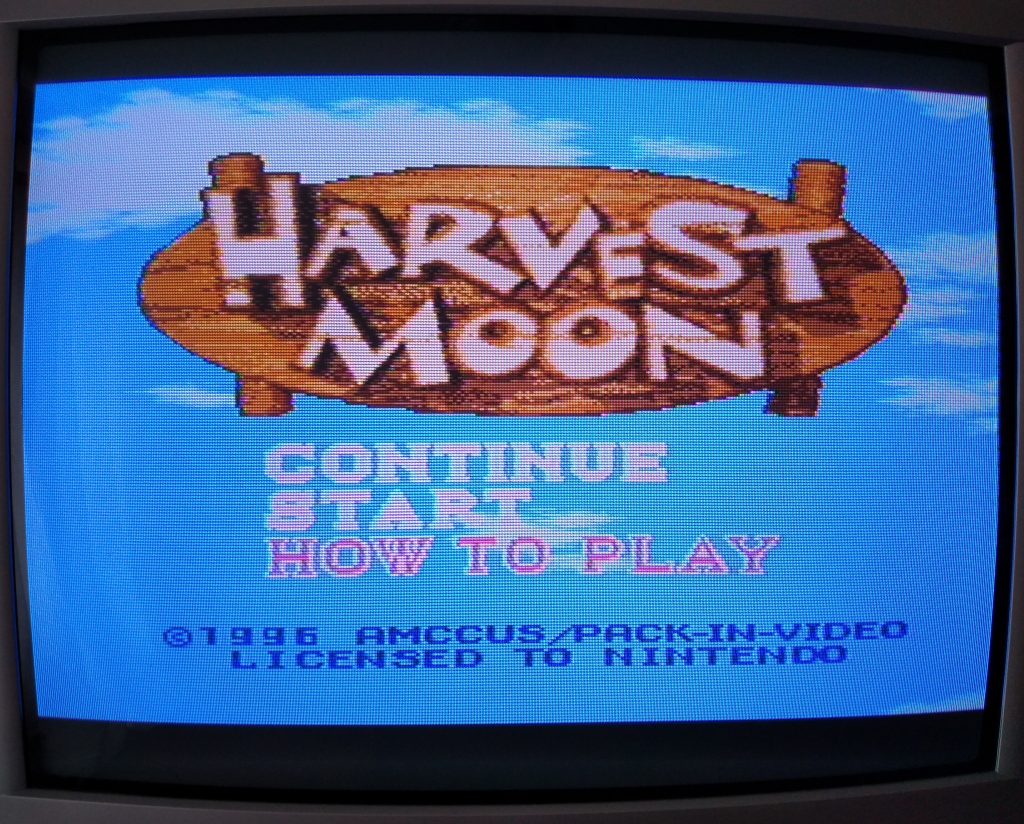
Gameplay
Harvest Moon is a slow paced farmer simulation game. You play as a young man who gains a farm that has fallen into disrepair. The player has 2.5 in-game years to fix the farm up before your father comes to evaluate you.
A year has 4 seasons existing of 30 days. This means you have 300 in-game days to make the best farm there is. There are 4 kind of animals to obtain (1 dog, 1 horse, chickens and cows with a max of 12) and 4 different crops (turnips, tomatoes, potatoes and corn) as well as grass (which is fodder for the animals!).
The game exists out of 3 primary areas; your farm, the town and the mountains.
Players will have to manage time in order to get all their daily tasks done. This includes taking care of livestock (feeding, talking to, brushing, milking, etc.) as well as produce (planting, watering, picking, etc.).
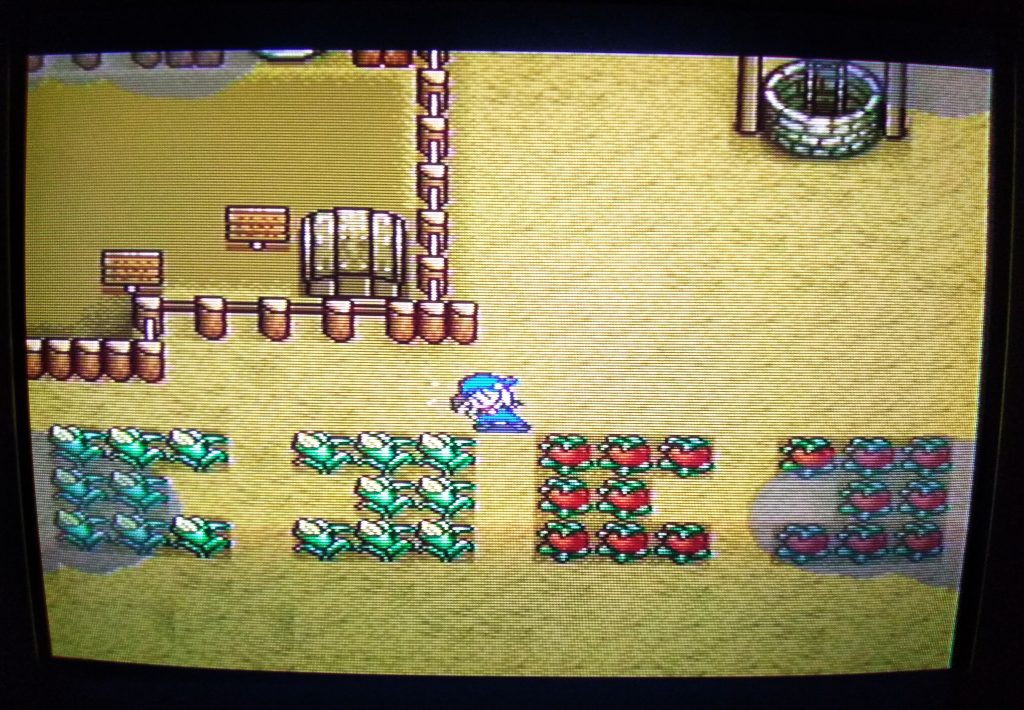
Alongside that they also need to plant grass to gain food / hay for the animals, and they can forage for wood and other items to sell. With the wood the Player can extend their farm house and build fences.
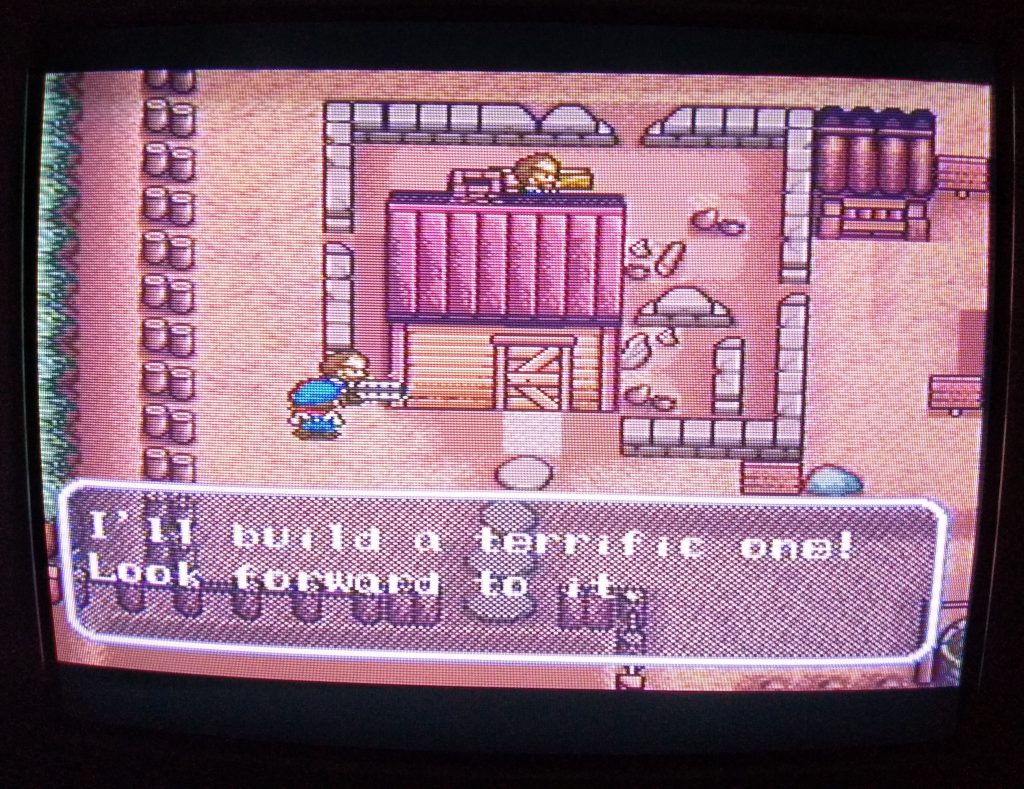
Certain crops only grow in certain seasons, and crops have different grow times as well, so it’s also important to plan ahead. The weather can also play a role!
Every day at 5p.m. the Head Shipping Man will pick up your items and ship them for you. So you need to be ready by then!
Apart from all that farming, there are also characters to interact with in town and in the mountains. There are 26 characters besides you, 5 of those are girls you can date and even marry.
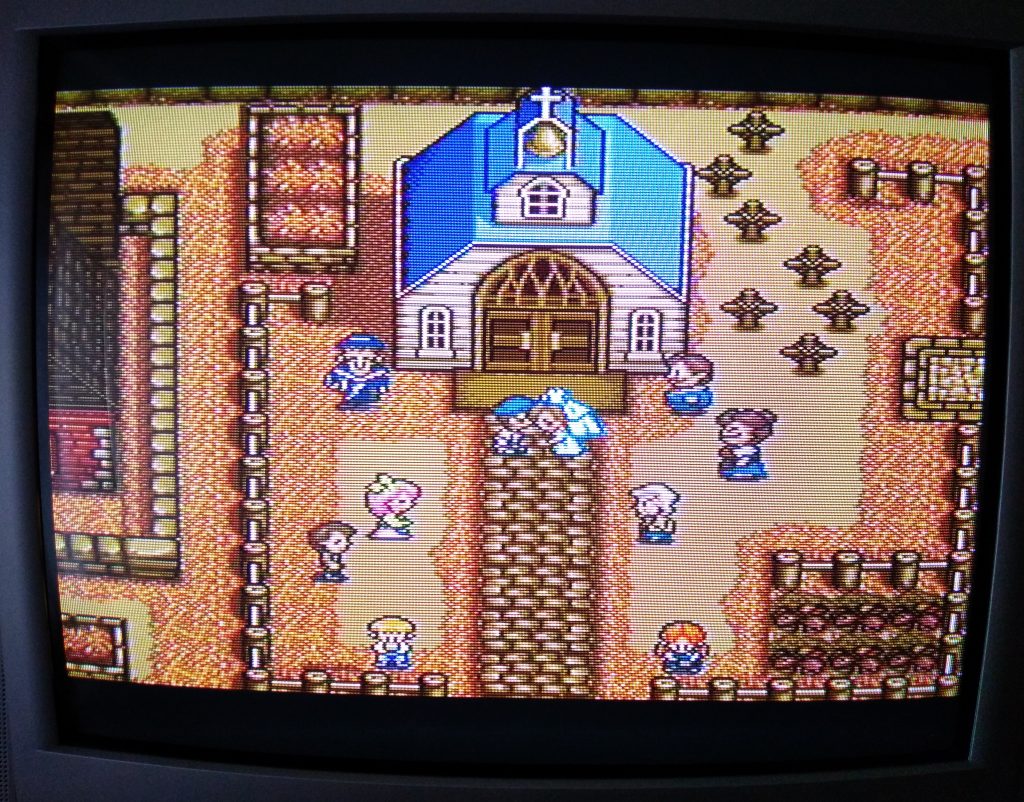
The game has several festivals as well. Along side that there are also events that can be triggered. A hawker can visit you and sell you some items you can’t obtain otherwise, a hurricane can destroy bits of your farm and girls will go on various dates with you if you’re nice to them. You can even get babies!
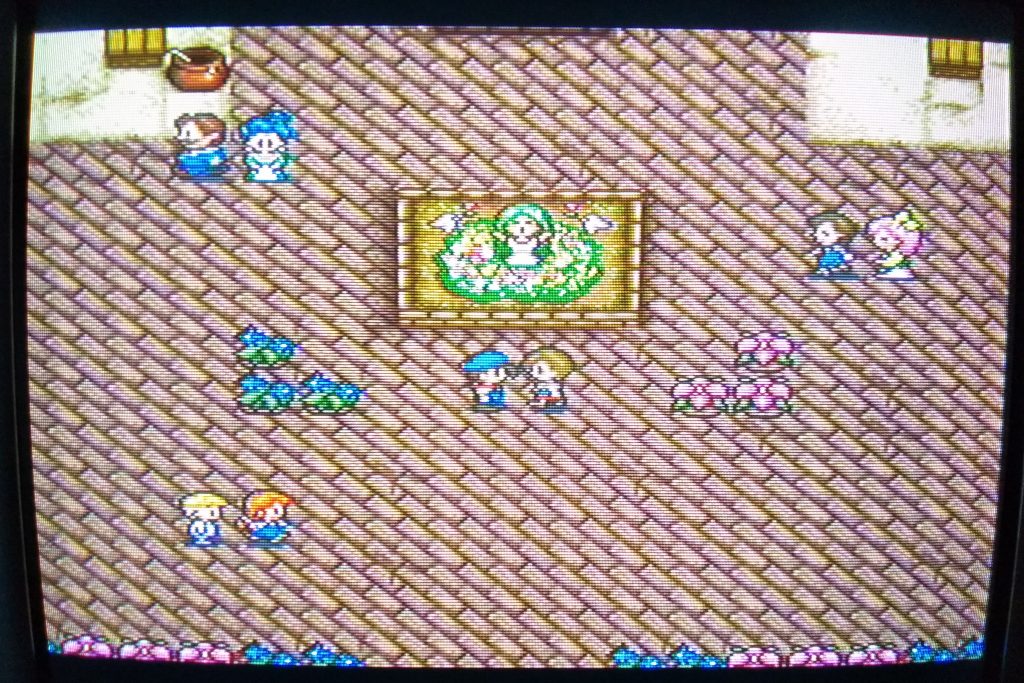
And there are tons of secrets to unlock like better tools, cool items and Power Berries, which, as the name might suggest, give you more energy to get more work done.
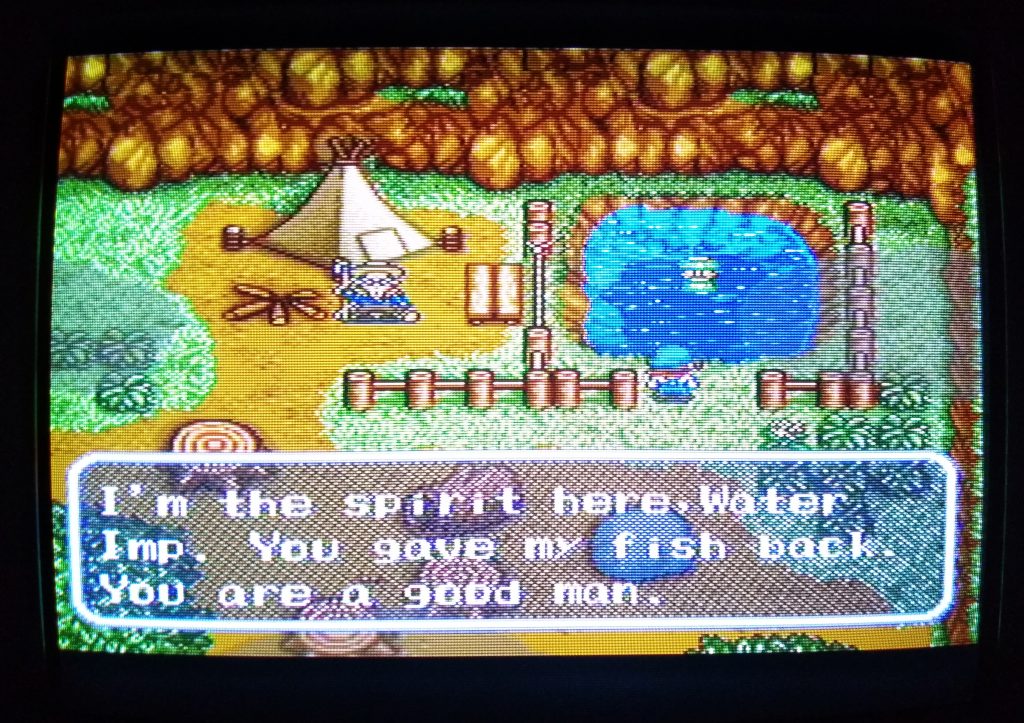
There is tons to do and many ways to do it in, no two playthroughs will ever be the same. And it has several different endings to unlock!
Development
The inspiration for the Harvest Moon series came from Yasuhiro Wada, who was the producer on this game. He had moved to Tokyo from the Japanese countryside.
“When I was in the city, I started reminiscing about what was good about where I came from, what made the countryside so special. That’s where some of the key concepts for Harvest Moon came from.” – Yasuhiro Wada
He wanted to create a new kind of RPG that had no combat in it, and instead focused on life in the country side. This was a way to create his nostalgic memories of home.
The look and feel of the game was inspired by various other video games of the time. The way the player interacts with the environment using tools was inspired by the Legend of Zelda. Yasuhiro Wada had also been playing a game called Derby Stallion, a video game that was a combination of horse racing and business simulation. This became the inspiration of taking care of and raising animals. The concept became of working on a ranch, where you could also maintain and sell crops. If doing well, your farm would grow larger, which was influenced by Sim City.
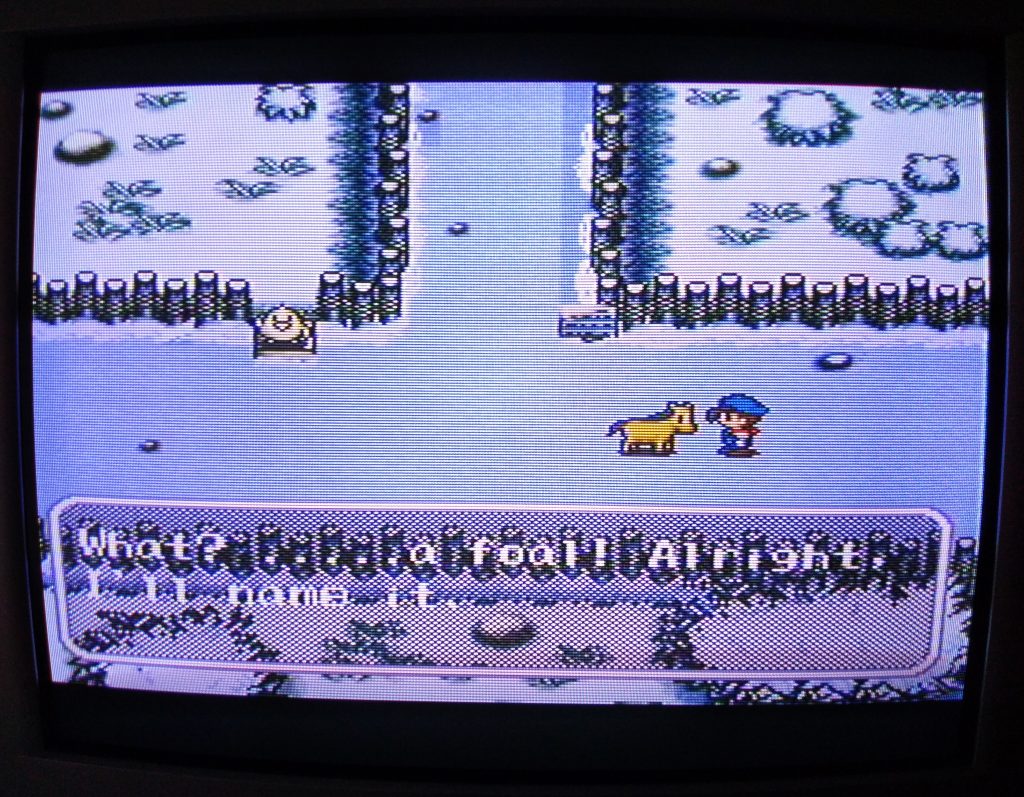
To keep the game fun, Yasuhiro Wada crafted a carefully balanced cycle where working hard had a nice payoff or reward. He also did not want many statistics in the game but simply focus on the simple pleasures of country life. Players would be able to gauge their progress through seeing visual cues, and more would be shown as the game progressed. The “judging” at the end of the game is based on a “score” unknown to the player. The game’s code keeps track of various things, for example how many crops have been sold, but also more mundane things like how many times you’ve hugged your dog!
The initial title in Japanese was Jinsei Bokujō or “Farm Life”, but was later changed to 牧場物語 Bokujō Monogatari or “Farm Story”. Outside of Japan the name became “Harvest Moon”.
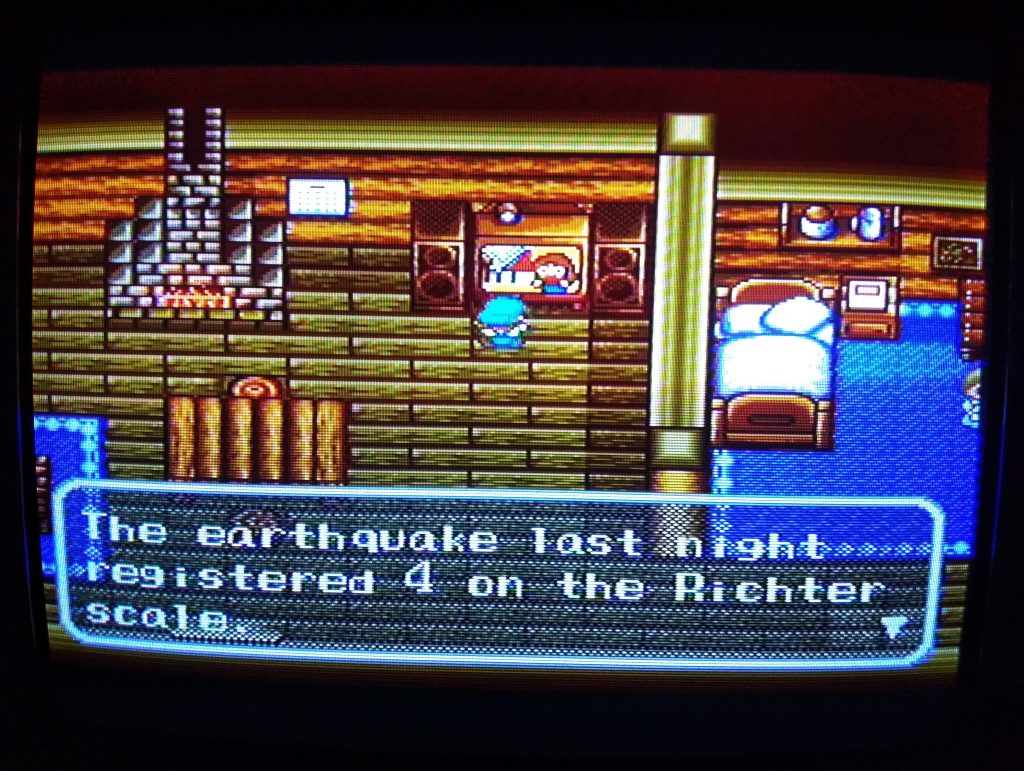
The development of Harvest Moon wasn’t an easy one. The game struggled to gain depth and be fun at first, and it took many iterations to get it “right”. Raising animals alone wasn’t enough, so crops got added and seeing seeds sprout turned out to be immensely gratifying. Marriage also became a strong social goal. But the game design wasn’t the only problem the development team faced. They struggled with the limitations of the SNES, and many ideas had to be scaled back or cut. On top of that they were dealing with the parent company’s financial strains.
The game nearly didn’t come out, but game planner Setsuko Miyakoshi and programmer Tomomi Yamatate convinced Yasuhiro Wada to keep going, and the 3 of them worked around the clock for 6 months on a limited budget from nearly scratch to get the game done.
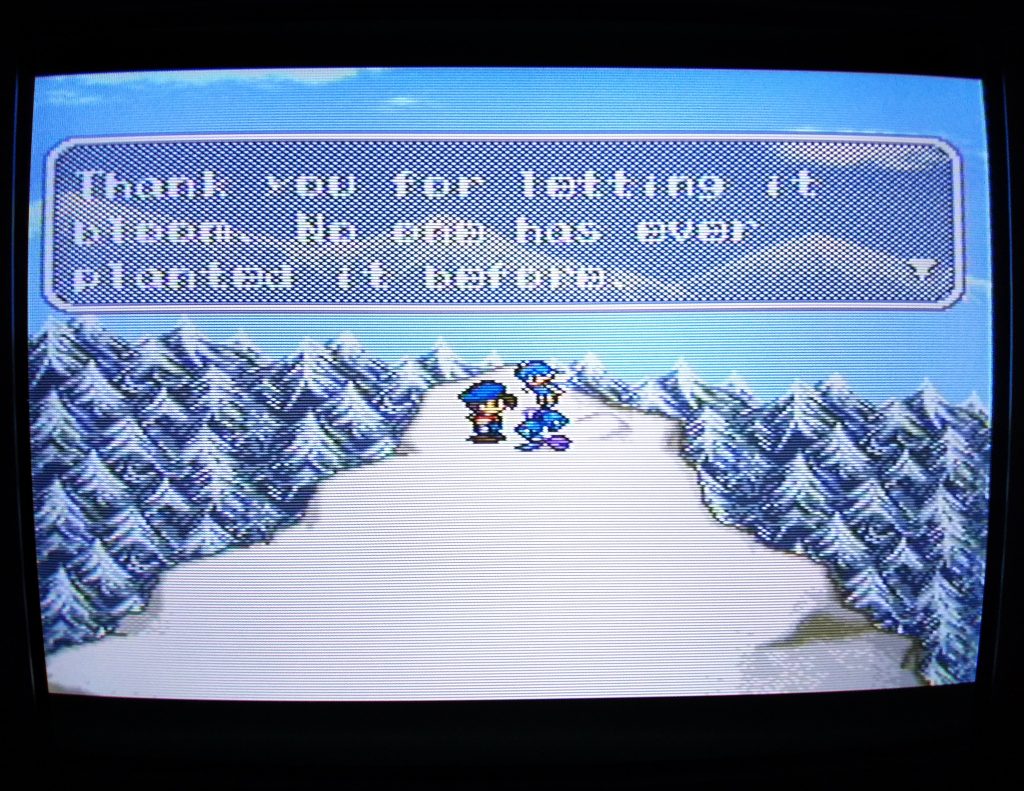
The game started slow but as word of mouth spread became a success. Although Yasuhiro Wada didn’t want to make a sequel at first, he felt obligated to the company that had stood behind his project. Both the GameBoy version and the N64 version became great successes. Yasuhiro Wada feels the N64 Harvest Moon was the closest to what he had envisioned, and had many ideas that were cut from the SNES version. But of all the games in the series, his favourite is A Wonderful Life on the GameCube, referencing the “Farm Life” title he had had for it all those years ago.
“It’s closest to the very original concept I had for Harvest Moon. The focus of A Wonderful Life is leading a full and happy existence from beginning to end, so in essence, it’s what I always intended Harvest Moon to be.” – Yasuhiro Wada
Yasuhiro Wada gave an amazing talk at Game Developer Conference in 2012 about the development of Harvest Moon for the SNES. The video can be seen here, with English audio here and the slides here.
Localisation
Several things changed when it got localised. In the Japanese version, the title is made out of hand-drawn planks of wood nailed together. For all other releases, this was replaced with a 3D-rendered sign.
Many elements of the game were also Westernized for its release in the US and later Europe. As a result, the church contains a cross, however, the townsfolk will sometimes still discuss the church in Shinto terms and refer to multiple gods, including the Harvest Goddess.
Alcohol references were also removed. Whereas the Japanese game will say “wine”, this ended up being “juice” in western releases. This is only in text however, as characters still become intoxicated.
The Japanese version of Harvest Moon has art alongside the credits in a cute hand drawn style. These were all removed for the western releases.
After the credits, the Japanese version of Harvest Moon also displays おしまい (the end), which does not display in international releases.
Packaging
I only own the European version of Harvest Moon. To be more specific, the FAH version (France And Holland). I bought this back then at the ‘Intertoys’, a local toy shop in the Netherlands for ƒ39.99 (down from ƒ99.95!). The original stickers are still on the box.
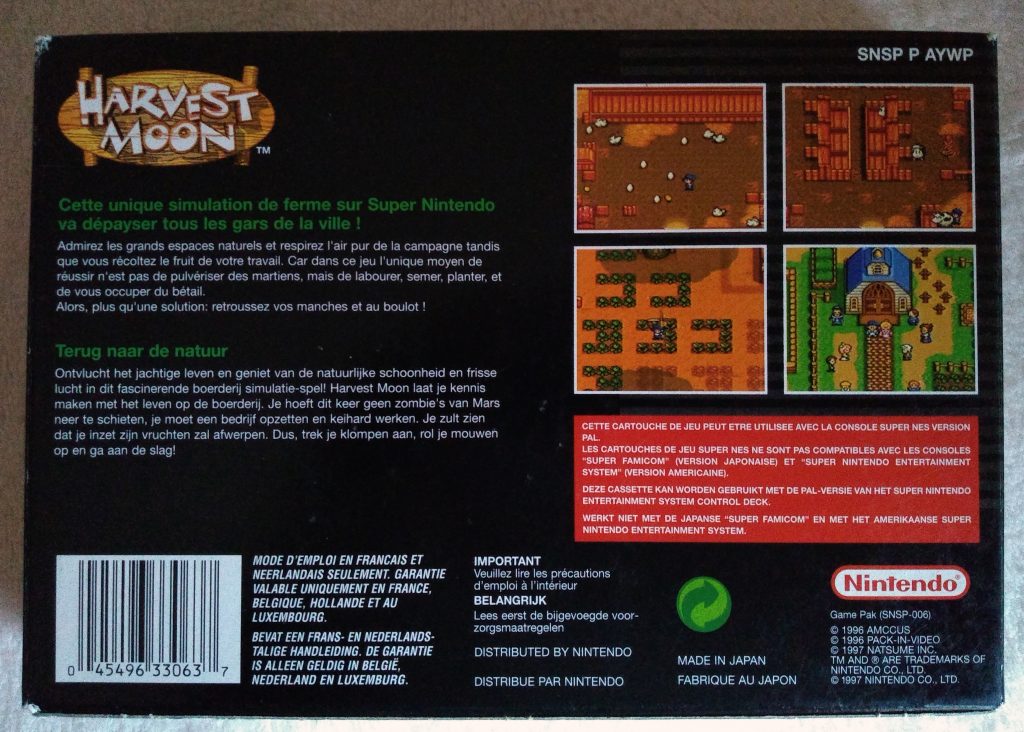
The back contains text in French and Dutch, but the game itself is in English. The text is interesting as it makes it clear there is no combat in this game, which was fairly unique at the time, by stating “instead of zapping zombies from Mars”. I also love the localisation in the text, where the Dutch one has “Trek je klompen aan” which means “Put on your clogs”.
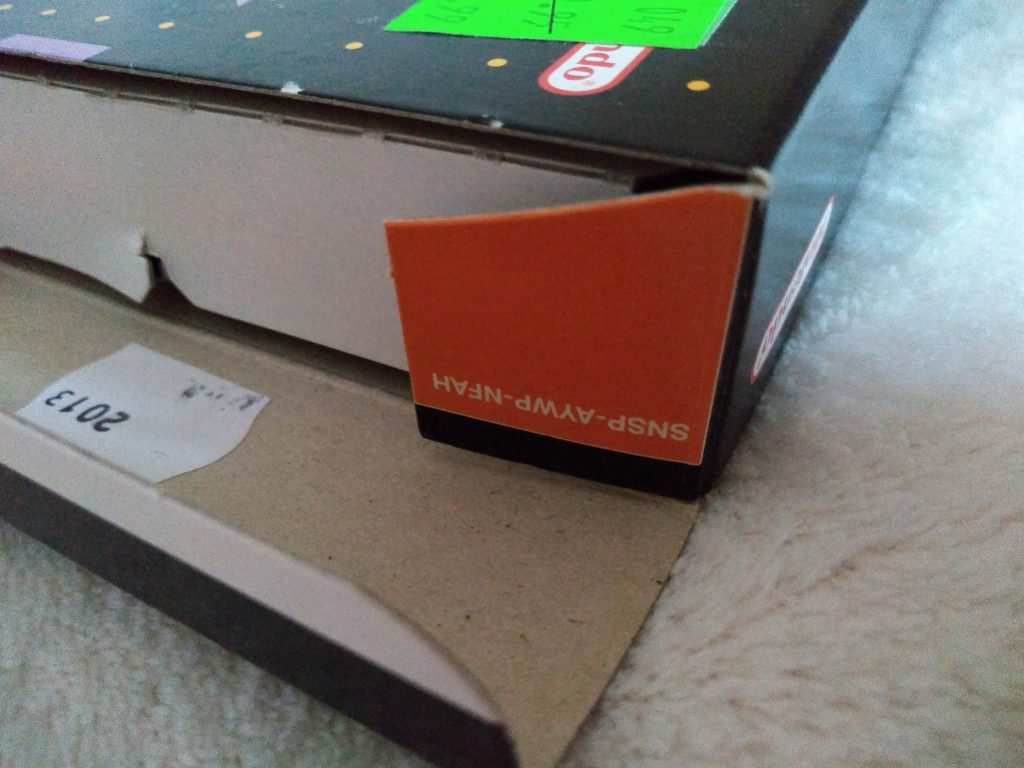
The box’s lid flap is orange, with the code SNSP-AYWP-NFAH. The game cartridge has SNSP-AYWP-EUR. The P in the middle section refers to PAL, and will have English text in-game. FAH means France and Holland, so this is the box and manual distributed in the Netherlands (and possibly Belgium / France), and the game itself is distributed in Europe (EUR).
I seem to have misplaced my manual but when I find it I will update it here as well.
Furthermore the game came with a standard SNES warning booklet regarding epilepsy etc, and 2 leaflets advertising the latest Gameboy, Super Nintendo and Nintendo 64 games.
Accessibility
- Visual
The game uses a lot of unique sprites to differentiate between things. The only thing that could possibly be a challenge is that the seed bags have as only difference between them colour (green for grass, red for tomatoes etc.) and may be hard to differentiate for the colour blind.
The text is fairly large, can take up to 3 lines and covers about a third of the screen. It is in an easy to read font in white, on a semi-transparant darker background (see below for an example). On lighter backgrounds (in Winter) it may be harder to read.
There is no option to change the language in the game. - Fine-Motor
The game doesn’t require any fast paced input or precision action (sprites are quite big and forgiving). Although being fast might help to min-max the game to get the most out of the in-game day, it can be played fairly leisurely.
Control wise, the game does not allow for re-mapping of buttons.
The [D-Pad] is used for moving, [Y] uses the active tool in hand, [X] toggles between the tools you’re using, [B] (hold) is used to sprint or jump over fences and [A] is the main action button (speak to people, examine, pick up items etc.). [L] is used to call your dog and [R] to call your horse. [Select] pauses the game. At a minimum, you’d need the [D-Pad], [Y] and [A] buttons to be able to play the game. - Auditory
Most actions have their own unique SFX (sound effect) so you are able to tell what you are doing. A successful and fail SFX are also present for some actions.
If the Player walks against a wall, the footsteps SFX will keep playing without a ‘thump’, so keep this in mind when playing (partial) blind.
Each Season has its own theme song. The weather also has different sounds (rain).
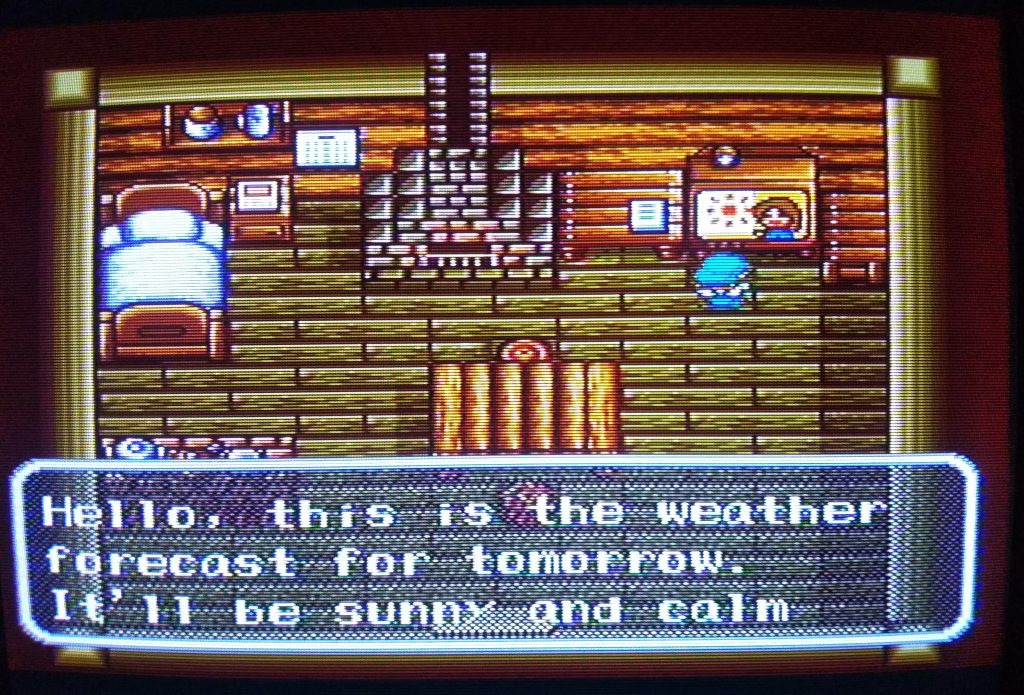
- Cognitive
The game has a repeatable rain / snow pattern effect.
If you don’t get the clock you have to tell / remember the time by in-game clues (at noon you eat, at 3pm the sun starts to set, at 5pm it’s dark).
You kind of have to remember which 2 tools you are carrying and which one is active, but you can check this by pausing (shows active tool) and [x] (toggles tools). I have often accidently used / dropped my seeds by forgetting it’s my active tool.
You have to remember what each girl likes (or dislikes).
Cows and chickens can die. Cows get a funeral.
You can pick up the dog, which counts as a pet / hug.
Power Up
I remember the first time I played this. I was around 10 or 11, the game was fairly new at the time and still for sale in the local toy shop ‘Intertoys’. I had looked at it many times, the screenshots looking cute but the main image on the box was not appealing to me (the American and Japanese box art is so much more my style!). I had only enough money saved to buy one game, and I struggled to choose.
One of my brother’s friends had Harvest Moon. I was over at their house to pick up my brother with my mom. As parents do, they started chatting, and my brother and his friend we’re hanging out so I ended up with said friend’s younger brother. He was playing Harvest Moon on their SNES and was trying to court Maria, but was having a hard time (I think he also struggled with the language, they had a German version). I helped him out a bit in the short time we had but it wasn’t enough. He gave me the game to borrow (with permission from his big brother) to play on his save file and marry Maria.
That was it. I played the game for a week and got up to the wedding day for him. I also started my own save file on the other slot. Although my German was limited, to this day I remember “Koro! Warte!” as your dog runs up your land.
After the week was over, I gave him the game back (he was really happy!) and went to buy the last copy in Intertoys.
I’ve played that game a million times. I know all its secret and I even had the Super Farmer Ending (until my little brother deleted that save to make his own!).
I loved figuring everything out that was possible in the game. I made lists of how long produce grew, what was available in the mountains in what season, etc. The different endings made me replay it over and over. It was the first game I’ve played back then that did that as well. My favourite girls are Ellen as she likes animals like me and Ann as she’s a tomboy engineer like me. 🙂
I also really like how there is so little UI. There are no scores or numbers or anything, but everything is visually present. The weather is visible, time is told through visual cues (you eat at 12pm, sunset is at 3pm causing an orange glow, dark at 6pm etc.), the shed is basically your inventory menu, cows look happy or sick, you perform little animations letting you know your stamina level (you start to sweat when getting tired for example) and NPCs react differently to you depending how much they like you. It’s something I really appreciate now more than when I was younger, but I find it a really nice touch.
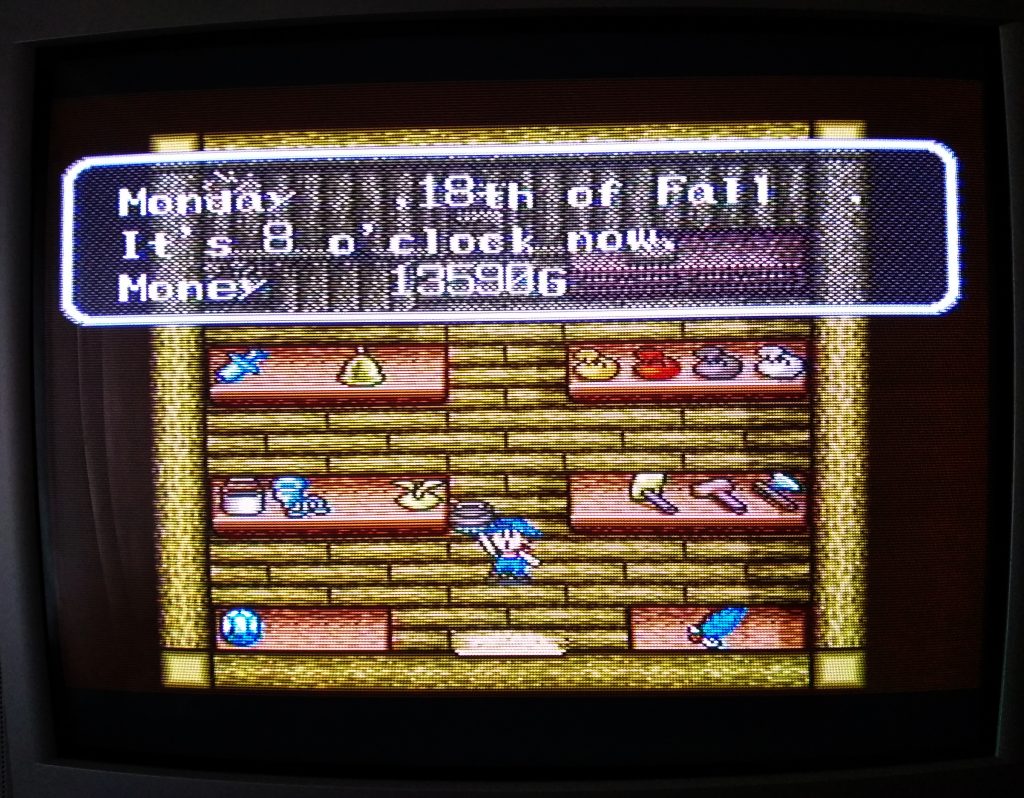
I also love animals and grew up in the country side, so this game hits home for me.
Combined with the cute style I love that is so common on the SNES, this game is definitely one of my favourites of all time. I even started replaying it again to get the screenshots for this blog. It’s still so good!
Recommendation
This game still holds up today. The 16-bit graphics still look nice and the music is catchy (I still remember every tune!). The characters are cute (albeit simple in terms of AI / depth) and the events and secrets kept me going in an attempt to see them all.
Nintendo had re-released the game on the Virtual Console on the Wii and Wii U, which proves people still love this gem.
Harvest Moon has grown into a popular series with many games, but none really matched the first one in my opinion. Yes it doesn’t have that many animals or crops and it could get repetitive, but there was something there that I never felt in the next Harvest Moon games. Maybe less is more.
If you like something simple and mellow (but can get stressful to get everything done in a day, mind!), cute characters in a chibi, 16-bit pixel style, enjoy nature and like to hone your time management skills I recommend this game. If you’re familiar with the newer Harvest Moon games in the series but not this one it’s definitely worth checking out its roots. If you don’t like repetition and need more action in your life, Harvest Moon will never be the game for you sadly.

Did you play this game? What are your memories of it? Are you thinking of playing this? Is there any information you’re missing? Let me know in the comments below!